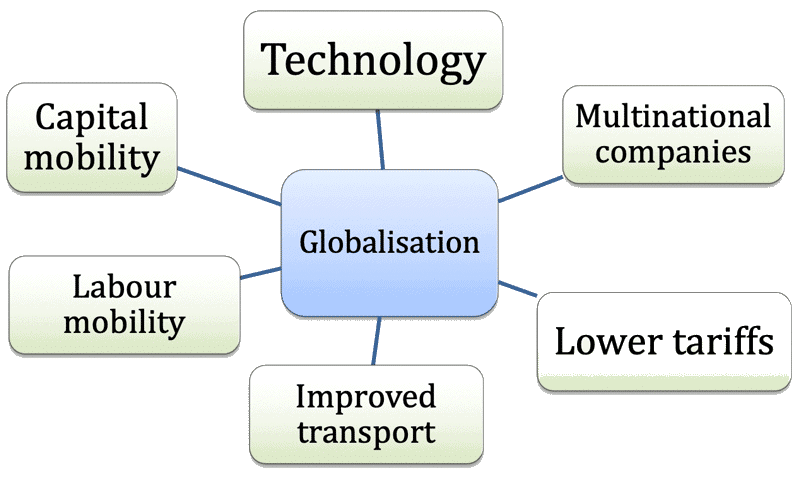Globalisation and it's Drivers | UGC NET Commerce Preparation Course PDF Download
| Table of contents |

|
| Globalization Overview |

|
| Economic Globalization |

|
| Causes of Globalization |

|
| Effects of Globalization |

|
| Top Multinational Companies |

|
Globalization Overview
Globalization refers to the growing interconnectedness between nations and people worldwide through trade, culture, technology, and ideas. As globalization has advanced, many aspects of daily life that were once local or national have become global, influencing a wide range of activities and interactions.
Global Company Definition
 A global firm, also known as a transnational corporation, operates in multiple countries around the world. Examples of global companies include:
A global firm, also known as a transnational corporation, operates in multiple countries around the world. Examples of global companies include:
Toyota: This Japanese automaker designs and manufactures vehicles sold in over 170 countries. With production and engineering facilities worldwide, Toyota manages a complex global supply chain to meet international market demands.
Walmart: Originally a local retailer in the U.S., Walmart is now the world's largest company by revenue, operating over 11,500 stores in 27 countries and employing more than 2 million people. Walmart's global presence is supported by its extensive international sourcing and operations.
Coca-Cola: This American beverage giant offers over 3,500 products in more than 200 countries. Coca-Cola's global network includes production facilities, marketing, and distribution systems, with a significant portion of its revenue coming from outside the U.S.
Economic Globalization
 Economic globalization involves integrating national economies into the global economy through trade, foreign investment, and financial flows. It encompasses the increasing movement of goods, services, capital, technology, and information. Factors such as reduced trade barriers, multinational production networks, and technological advances have significantly driven economic globalization in recent decades.
Economic globalization involves integrating national economies into the global economy through trade, foreign investment, and financial flows. It encompasses the increasing movement of goods, services, capital, technology, and information. Factors such as reduced trade barriers, multinational production networks, and technological advances have significantly driven economic globalization in recent decades.
| 1 Crore+ students have signed up on EduRev. Have you? Download the App |
Example of a Global Company
Apple Inc.: Established in 1976 in California, Apple has become one of the leading tech companies globally. It designs, manufactures, and markets products like the iPhone, iPad, Mac, Apple Watch, and Apple TV, along with related software and services. Apple operates across multiple regions, including the Americas, Europe, Greater China, Japan, and Asia Pacific, using various sales channels such as retail stores, online platforms, and third-party resellers. The company's successful global business model and brand reputation contribute to its high revenue and market value.
Drivers of Globalization
Several factors have fueled globalization in business:
Technological Advancements: Innovations such as the internet, smartphones, advanced transportation, and improved logistics facilitate global connections and operations.
Reduction in Trade Barriers: The lowering of tariffs and quotas through trade agreements and organizations like the WTO has made international trade and investment more accessible.
Growing Consumer Demand: Rising incomes in emerging markets have created a larger global consumer base seeking goods and services from around the world.
Search for Lower Costs: Companies globalize to find cost-effective labor, resources, and suppliers, often through offshoring and outsourcing to reduce operational expenses.
Access to Skills and Talent: Globalization provides businesses with access to a diverse pool of skills and expertise that can drive innovation and growth.
Liberalization of Capital Flows: Deregulation and liberalization of capital markets have enabled freer movement of capital across borders, facilitating global investment.
Global Expansion Strategies: Large firms pursue international expansion to access new markets, resources, and growth opportunities beyond their domestic borders.
International Business Environment
The international business environment encompasses all external factors influencing firms operating across multiple countries. Businesses face a complex and dynamic environment when expanding into the global marketplace. This environment includes:
- Political Environment: The stability, policies, and regulations of foreign governments, which can impact business operations.
- Economic Environment: The economic conditions, development levels, and trade policies of other countries.
- Socio-Cultural Environment: The demographic, cultural, and social norms of international markets that affect consumer behavior.
- Technological Environment: The level of technological advancement, infrastructure, and innovation in different regions.
- Legal Environment: The laws, regulations, and intellectual property protections in various nations.
These factors present both challenges and opportunities for global firms. Companies must adapt their strategies and operations to fit the specific conditions of each foreign market. Challenges include exchange rate risks, trade barriers, cultural differences, political risks, and regulatory compliance. However, expanding into global markets also offers growth opportunities beyond domestic borders.
Importance of International Business
The significance of international business is highlighted by:
- Access to New Markets: Selling goods and services in global markets can provide new revenue sources and growth opportunities.
- Economies of Scale: Expanding globally can lead to larger economies of scale in production and supply chain management, reducing per-unit costs.
- Diversification of Risk: Global operations spread risks across different markets, reducing reliance on any single domestic market.
- Access to Resources: Globalization provides access to natural resources, raw materials, labor, talent, and technologies from around the world, enhancing efficiency and innovation.
- Higher Profits: Successfully entering global markets can result in higher profits through increased growth, lower costs, and premium pricing.
- Competitive Advantage: Global expansion may be essential for firms to compete effectively and maintain their positions against multinational competitors.
- Spurring Innovation: Engagement with global markets, clients, and talent can lead to new ideas and technologies, fostering innovation and the development of new products and services.
- National Economic Benefits: Domestic firms engaging in global trade can positively impact the national economy through exports, foreign direct investment, job creation, and tax revenues.
Causes of Globalization

The driving forces behind globalization include:
- Technology: Advances in technology, such as the internet, mobile phones, and sophisticated software, enable faster and cheaper communication, transportation, and data processing across borders.
- Trade Liberalization: Governments have reduced trade barriers like tariffs and quotas through trade agreements, facilitating international trade and investment.
- Transportation: Improvements in transportation infrastructure and technologies, including shipping containers and aircraft, have decreased the time and cost of moving goods between countries.
- Multinational Firms: Large firms expand operations internationally through foreign direct investment, global sourcing, and offshoring, spreading economic globalization.
- Growth of Services: The globalization of service industries such as finance, tourism, and IT has accelerated due to digitization and relaxed trade rules.
- Rise of Outsourcing: Companies increasingly outsource functions to lower-cost nations, integrating previously local activities into global supply chains.
- Standardization: Global standards in product quality, technology, and business practices facilitate coordination and integration of economic activities across borders.
- Economic Development: Emerging economic powers like China, India, and Brazil contribute new resources and markets to the global economy.
Advantages of Globalization
The benefits of globalization in business include:
- Economic Growth: Increased trade and investment from globalization can drive economic expansion, providing larger markets for businesses and boosting the overall economy.
- Increased Competition: Global competition motivates firms to innovate, become more efficient, and enhance productivity, driving progress.
- Access to Capital: Globalization opens up larger pools of international capital for firms and nations, funding business expansion and development projects.
- Access to Resources: Firms and nations can obtain natural resources, materials, technology, and talent from around the world, boosting productivity and innovation.
- Lower Prices: Global competition and access to lower-cost suppliers can lead to reduced prices for consumers.
- Increased Trade: Globalization breaks down trade barriers, facilitating the flow of goods and services across borders and increasing global trade volumes.
- Technology Transfer: Globalization accelerates the spread of technology and knowledge, benefiting developing nations with access to foreign innovation and expertise.
- Cultural Sharing: Globalization promotes the exchange of cultural goods and ideas, enriching societies by exposing people to new perspectives and ways of life.
- Employment Opportunities: Globalization creates more job opportunities in expanding industries and multinational corporations operating internationally.
 |
Download the notes
Globalisation and it's Drivers
|
Download as PDF |
Disadvantages of Globalization
Globalization in business has several drawbacks:
- Job Losses: Globalization has led to job losses in developed countries as companies move production and outsource services to lower-cost regions. This shift can negatively affect workers' incomes and job security.
- Increased Inequality: Globalization has contributed to widening income disparities both within and between nations. While multinational firms and high-skilled workers benefit, low-skilled laborers and the impoverished often suffer.
- Economic Volatility: The interconnected global economy can spread economic crises quickly. Financial instability in one country can impact economies worldwide.
- Loss of National Sovereignty: Globalization reduces the ability of national governments to set independent economic policies, as they must now account for global pressures and market forces.
- Threat to Local Cultures: The global spread of brands, media, and pop culture can overshadow local traditions and cultural diversity in some regions.
- Environmental Damage: The increase in global trade and economic activity has led to environmental issues such as pollution, resource depletion, and climate change.
- Exploitation Risks: Global supply chains can expose countries to poor labor practices and environmental standards that may go unregulated and unnoticed.
- Health Risks: Increased global travel, trade, and migration can accelerate the spread of diseases, raising the risk of pandemics originating from localized outbreaks.
- Tax Avoidance: Globalization allows multinational firms to avoid taxes by shifting profits across jurisdictions, reducing government revenue.
Effects of Globalization
 The impact of globalization on business includes:
The impact of globalization on business includes:
- Increased Trade and Investment: Globalization has significantly boosted international trade, foreign investment, and cross-border financial flows, integrating national economies.
- Access to Cheaper Goods: Consumers worldwide benefit from a wider variety of goods and services at lower prices due to imports and outsourcing.
- Economic Growth: Globalization has contributed to economic growth in many countries through expanded trade, increased efficiency, and technological diffusion, though benefits are unevenly distributed.
- Spread of Technology: Globalization has accelerated the dissemination of technology and innovation across borders, enhancing productivity.
- Rise of Outsourcing and Offshoring: Firms increasingly outsource and offshore operations to lower-cost countries, creating global supply chains.
- Transfer of Knowledge: The movement of people, information, and ideas across borders has facilitated the spread of knowledge and best practices.
- Increased Competitiveness: Firms face global competition, which drives them to improve efficiency, quality, and innovation, enhancing their global competitiveness.
- Job Losses in Certain Sectors: Some sectors in developed countries have experienced job losses due to competition from lower-cost foreign markets.
- Economic Environment of Business: Globalization has led to widening income gaps both between and within many nations, with varying impacts based on skills, industry, and adaptability to global changes.
Top Multinational Companies
The top global firms are leaders with extensive operations across multiple countries. The largest multinational companies by revenue include:
- Walmart: The American retail giant Walmart is the world's largest company by revenue, operating over 11,500 stores in 27 countries. More than 60% of its revenue comes from international markets.
- Amazon: As the largest online retailer globally, Amazon operates in over 200 countries, offering products, AWS cloud services, and a vast logistics network.
Types of International Marketing
International marketing strategies vary and include:
- Export Marketing: A company produces goods in one country and sells them in other countries, engaging in marketing activities such as promotion and distribution abroad. Exporting is the simplest form of international marketing.
- International Marketing: A company develops distinct marketing strategies tailored to different foreign markets, adapting the 4Ps (Product, Price, Place, Promotion) to each country's unique features and consumer needs.
- Multinational Marketing: A company operates in multiple countries with a decentralized approach, blending global strategies with local adaptations.
- Global Marketing: A company uses a standardized marketing mix across all major markets, focusing on achieving economies of scale through a unified strategy.
- Transnational Marketing: A hybrid approach where some products and brands are global, while others are tailored to specific countries or regions.
- Cross-Cultural Marketing: A company adjusts its marketing strategies to account for cultural differences, customizing ads, packaging, and pricing to local values and norms.
- Grey Market Marketing: A company sells products internationally without official export or distribution agreements, often through unofficial channels at discounted prices.
Conclusion
Globalization has transformed the business landscape by enabling companies to expand across national borders more easily than ever before. While it offers numerous opportunities for growth, it also presents challenges that companies must navigate. Developing strategies to leverage the benefits of global operations while mitigating risks is essential for success in the global market. Understanding and adapting to the complex global business environment is crucial for achieving global success.
|
235 docs|166 tests
|
FAQs on Globalisation and it's Drivers - UGC NET Commerce Preparation Course
| 1. What are the main drivers of globalization? |  |
| 2. How does economic globalization impact developing countries? |  |
| 3. What are some of the key causes of globalization? |  |
| 4. How do top multinational companies contribute to economic globalization? |  |
| 5. What are some of the effects of globalization on local economies? |  |

|
Explore Courses for UGC NET exam
|

|
















